人教版高中英语必修4 Unit 4 Body language Reading 1课件 (共37张)
文档属性
| 名称 | 人教版高中英语必修4 Unit 4 Body language Reading 1课件 (共37张) | 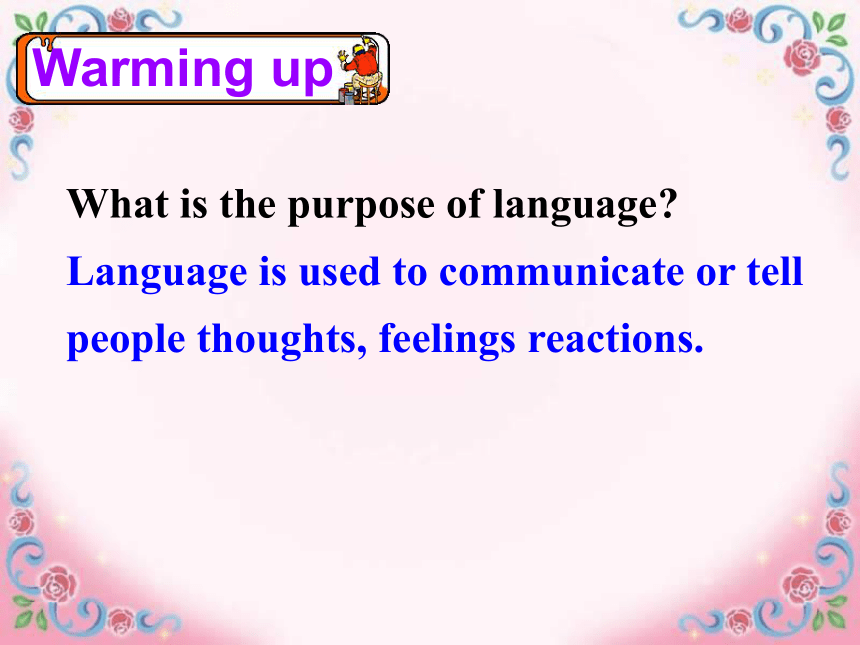 | |
| 格式 | zip | ||
| 文件大小 | 1.7MB | ||
| 资源类型 | 教案 | ||
| 版本资源 | 人教版(新课程标准) | ||
| 科目 | 英语 | ||
| 更新时间 | 2019-04-11 17:49:14 | ||
图片预览

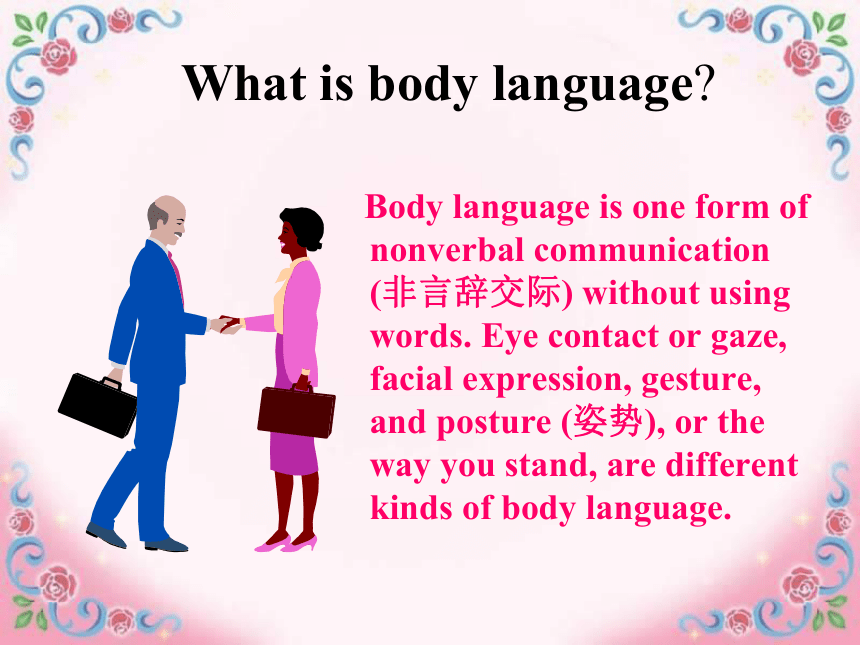
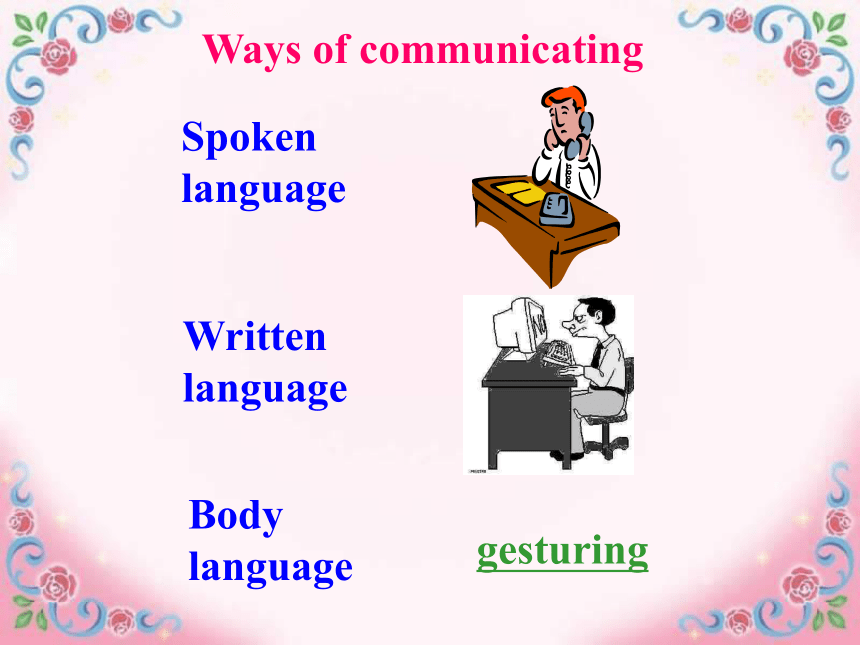

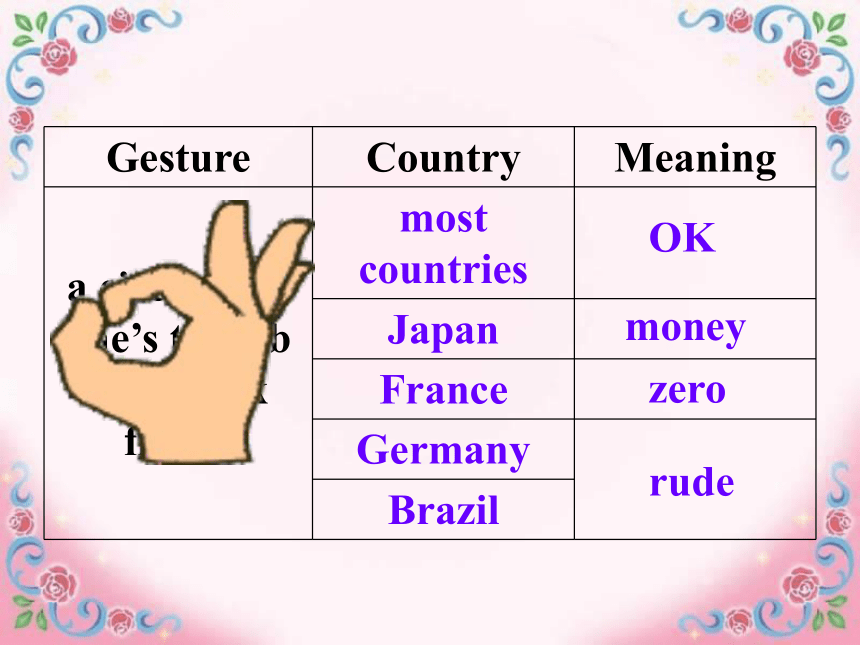
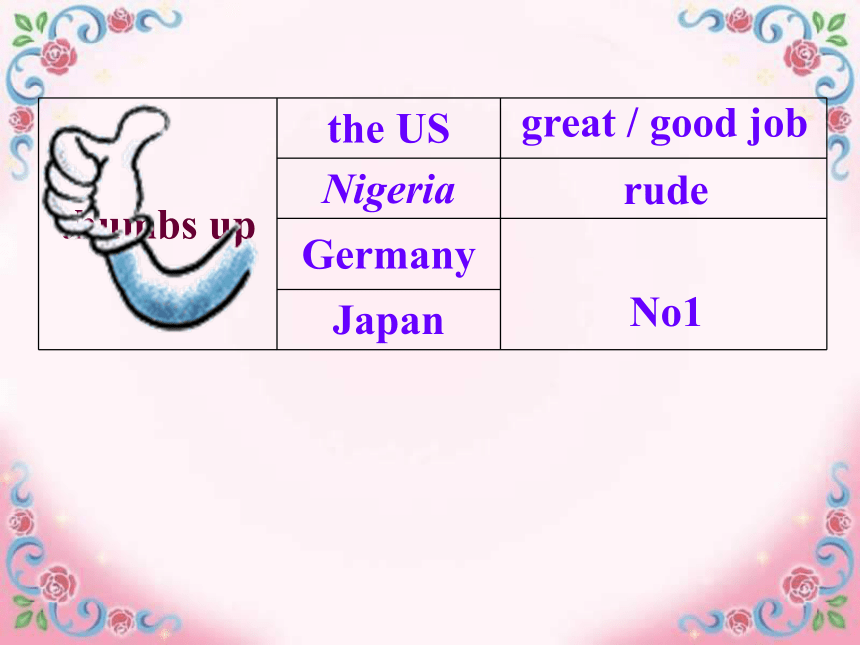
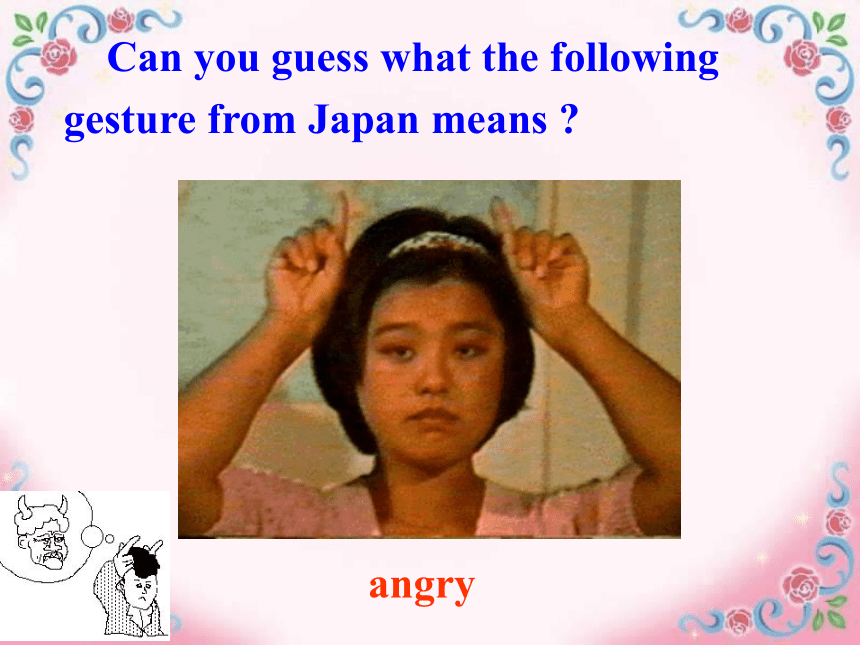

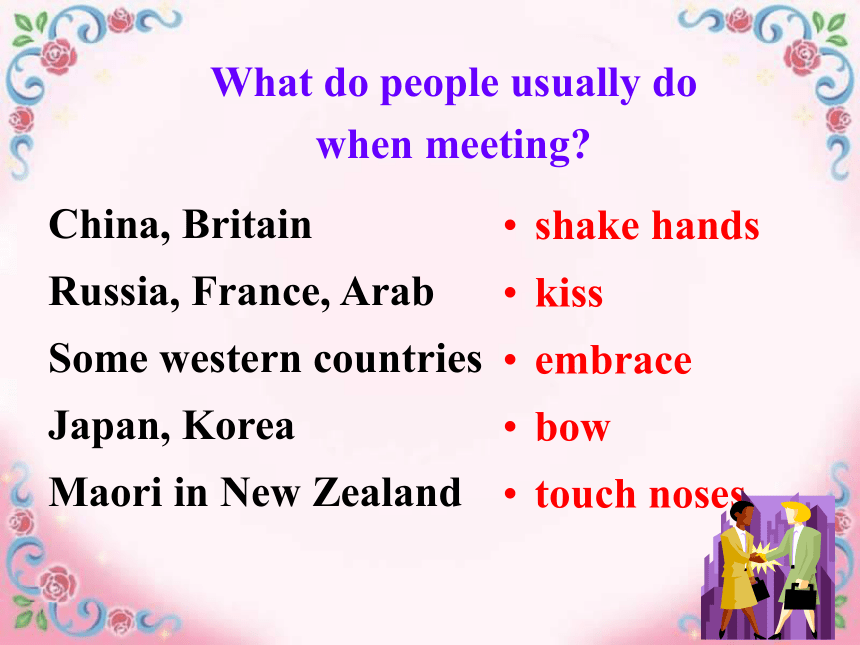
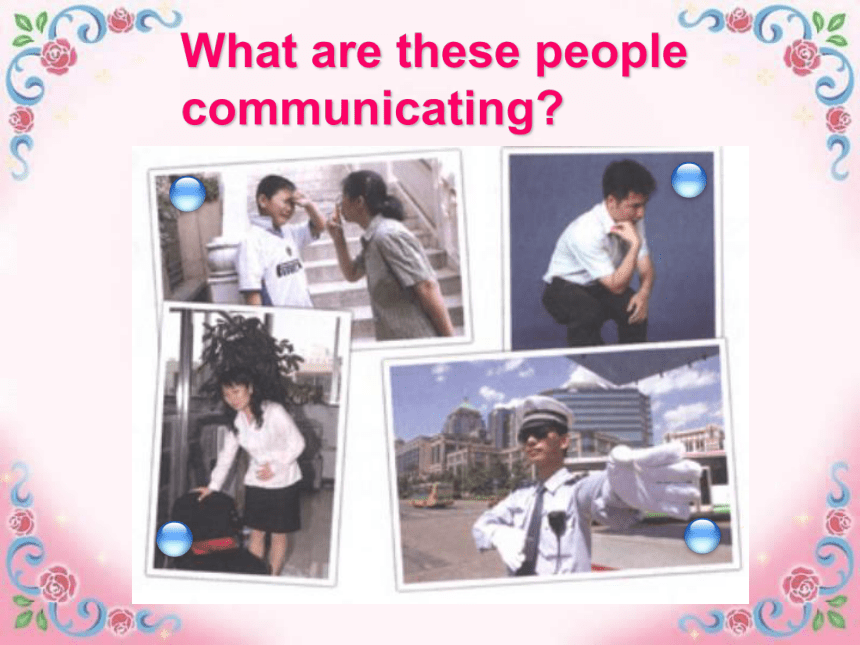
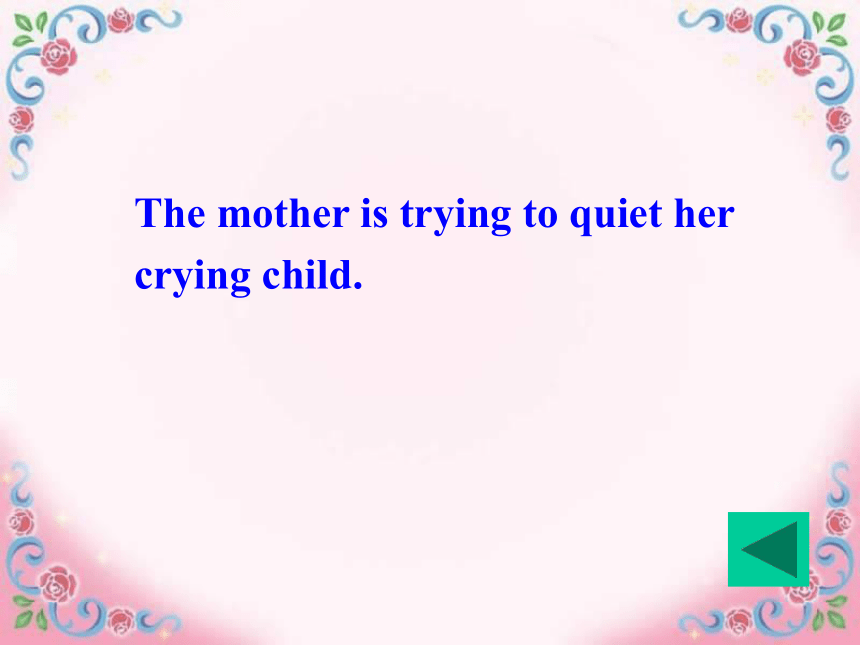

文档简介
课件37张PPT。Warming upWhat is the purpose of language?
Language is used to communicate or tell people thoughts, feelings reactions. What is body language? Body language is one form of nonverbal communication (非言辞交际) without using words. Eye contact or gaze, facial expression, gesture, and posture (姿势), or the way you stand, are different kinds of body language.Spoken
languageWritten
languageBody
languageWays of communicating gesturingsilentI love you.stopvictoryzerorudemoneyOKNo1rudegreat / good job Can you guess what the following
gesture from Japan means ?angry Can you guess what the following
gesture from France means ?I don’t believe you.What do people usually do when meeting?China, Britain
Russia, France, Arab
Some western countries
Japan, Korea
Maori in New Zealandshake hands
kiss
embrace
bow
touch nosesWhat are these people
communicating?The mother is trying to quiet her crying child. Someone is thinking deeply. Someone is feeling ill/having a stomachache. The policeman is directing traffic/telling cars to go. ReadingCommunication:
No problem?Predict what you think the topic will be? Tony Garcia (Columbia)Julia Smith (Britain)
George Cook (Canada)Japanese- Akira NagataReading comprehensionI. While reading, please try to divide the whole passage into several parts and find out the main idea.Part 1. (para. 1) You are sent to Capital International Airport to meet this year’s international students.Part 2 (para. 2 and 3 ) Examples of learned or cultural “body language”.Part 3. (para. 4 ) Different peoples have different body languages.Part 4. (para. 5) Summary of body language.II. How do different international
students behave when they greet people?
Complete the chart with information
from the passage.man from Colombiakiss on the cheekJulia Smithwoman from BritaineveryoneAkira Nagatabowing everyoneman from Canada shaking handseveryoneAhmed Aziz man from Jordanshaking hands noddingDarlene Coulonwoman from Francepeople she knows 1. Is the author of this passage male or female? How do you know ?
The author is male. Ahmed Aziz will not shake hands with women, but he shakes hands with the author.III. Answer questions2.What were the two mistakes that the author noticed?
He noticed that the Colombian man kissed the British woman, but in her culture, a kiss from a stranger is not acceptable. He also noticed that the Japanese man bowed just as the Canadian man started to shake hands, so one man’s nose touched the other man’s hand. 3. Who seemed to prefer to keep more physical distance from others? Who seemed to prefer closer physical distance ?
The British woman, Julia, and probably the Canadian man, George, seemed to prefer to keep more physical distance from others. The Colombian man, Tony, and the Jordanian man, Ahmed, seemed to prefer closer physical distance . 4. Did any students have similar greeting customs? If so, which ones?
Yes. Tony from Colombia and Darlene from France had a similar greeting custom-a kiss. George from Canada and Ahmed from Jordan also had a similar greeting custom-a handshake, but Ahmed shakes hands only with men.5. “ When in Rome, do as the Romans do.” What do you think this famous saying means?
This saying means that when we are in a certain place, we should follow the customs of the people who live in that place, not our own customs.6. Do you agree with the author’s statement that body language is not good or bad? Why or why not? Englishmen often stand close to others or touch strangers as soon as they meet.
Most people around the world now greet each other by kissing .IV. Read the text carefully, then decide if the following statements are true (T) or false (F). FF Japanese will bow to others as greeting.
People from Jordan will move very close to you as you introduce yourself to them.
Some body languages in some countries are good while some countries’ body language are bad.TT F People from different countries may have a major misunderstanding while greeting each other.
The physical distance from each other that people are comfortable with generally depends on the culture.
All members of a culture behave in the same way.TT F 1. What is the main idea of the text?
A. There are different customs in
different countries.
B. Foreigners should follow the
customs of the country where they
are visiting.
C. People use body movements to send
messages and different body
movements have different meanings.
D. The importance of knowing customs. V. Choose the correct one.2. If two men stand close to each other while talking, they cannot be from _____.
A. an Arab country B. USA
C. Britain D. Russia3. What should a Chinese young man do when he meets his Russian friend in Moscow?
A. Kiss him.
B. Nod his head to his friend.
C. Shake hands with him.
D. Smile at him. 4. If you go to some Asian countries, which of the following can you do?
A. Touch the head of a boy.
B. Nod your head to others.
C. Sit with your feet pointing at
another person.
D. Kiss each other.5. “Foreigners should follow these customs when they are visiting these countries.”
The underlined word here means ___.
A. habits B. fault
C. words D. performanceDiscussionIf you meet a foreigner who comes up close to you to talk, what countries might he be from? How can you show him that you are uncomfortable with that?
Language is used to communicate or tell people thoughts, feelings reactions. What is body language? Body language is one form of nonverbal communication (非言辞交际) without using words. Eye contact or gaze, facial expression, gesture, and posture (姿势), or the way you stand, are different kinds of body language.Spoken
languageWritten
languageBody
languageWays of communicating gesturingsilentI love you.stopvictoryzerorudemoneyOKNo1rudegreat / good job Can you guess what the following
gesture from Japan means ?angry Can you guess what the following
gesture from France means ?I don’t believe you.What do people usually do when meeting?China, Britain
Russia, France, Arab
Some western countries
Japan, Korea
Maori in New Zealandshake hands
kiss
embrace
bow
touch nosesWhat are these people
communicating?The mother is trying to quiet her crying child. Someone is thinking deeply. Someone is feeling ill/having a stomachache. The policeman is directing traffic/telling cars to go. ReadingCommunication:
No problem?Predict what you think the topic will be? Tony Garcia (Columbia)Julia Smith (Britain)
George Cook (Canada)Japanese- Akira NagataReading comprehensionI. While reading, please try to divide the whole passage into several parts and find out the main idea.Part 1. (para. 1) You are sent to Capital International Airport to meet this year’s international students.Part 2 (para. 2 and 3 ) Examples of learned or cultural “body language”.Part 3. (para. 4 ) Different peoples have different body languages.Part 4. (para. 5) Summary of body language.II. How do different international
students behave when they greet people?
Complete the chart with information
from the passage.man from Colombiakiss on the cheekJulia Smithwoman from BritaineveryoneAkira Nagatabowing everyoneman from Canada shaking handseveryoneAhmed Aziz man from Jordanshaking hands noddingDarlene Coulonwoman from Francepeople she knows 1. Is the author of this passage male or female? How do you know ?
The author is male. Ahmed Aziz will not shake hands with women, but he shakes hands with the author.III. Answer questions2.What were the two mistakes that the author noticed?
He noticed that the Colombian man kissed the British woman, but in her culture, a kiss from a stranger is not acceptable. He also noticed that the Japanese man bowed just as the Canadian man started to shake hands, so one man’s nose touched the other man’s hand. 3. Who seemed to prefer to keep more physical distance from others? Who seemed to prefer closer physical distance ?
The British woman, Julia, and probably the Canadian man, George, seemed to prefer to keep more physical distance from others. The Colombian man, Tony, and the Jordanian man, Ahmed, seemed to prefer closer physical distance . 4. Did any students have similar greeting customs? If so, which ones?
Yes. Tony from Colombia and Darlene from France had a similar greeting custom-a kiss. George from Canada and Ahmed from Jordan also had a similar greeting custom-a handshake, but Ahmed shakes hands only with men.5. “ When in Rome, do as the Romans do.” What do you think this famous saying means?
This saying means that when we are in a certain place, we should follow the customs of the people who live in that place, not our own customs.6. Do you agree with the author’s statement that body language is not good or bad? Why or why not? Englishmen often stand close to others or touch strangers as soon as they meet.
Most people around the world now greet each other by kissing .IV. Read the text carefully, then decide if the following statements are true (T) or false (F). FF Japanese will bow to others as greeting.
People from Jordan will move very close to you as you introduce yourself to them.
Some body languages in some countries are good while some countries’ body language are bad.TT F People from different countries may have a major misunderstanding while greeting each other.
The physical distance from each other that people are comfortable with generally depends on the culture.
All members of a culture behave in the same way.TT F 1. What is the main idea of the text?
A. There are different customs in
different countries.
B. Foreigners should follow the
customs of the country where they
are visiting.
C. People use body movements to send
messages and different body
movements have different meanings.
D. The importance of knowing customs. V. Choose the correct one.2. If two men stand close to each other while talking, they cannot be from _____.
A. an Arab country B. USA
C. Britain D. Russia3. What should a Chinese young man do when he meets his Russian friend in Moscow?
A. Kiss him.
B. Nod his head to his friend.
C. Shake hands with him.
D. Smile at him. 4. If you go to some Asian countries, which of the following can you do?
A. Touch the head of a boy.
B. Nod your head to others.
C. Sit with your feet pointing at
another person.
D. Kiss each other.5. “Foreigners should follow these customs when they are visiting these countries.”
The underlined word here means ___.
A. habits B. fault
C. words D. performanceDiscussionIf you meet a foreigner who comes up close to you to talk, what countries might he be from? How can you show him that you are uncomfortable with that?
同课章节目录
